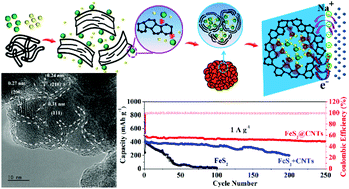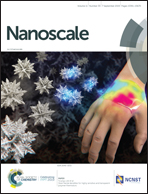Turbostratic carbon-localised FeS2 nanocrystals as anodes for high-performance sodium-ion batteries†
Abstract
Low-cost metal sulfides are promising anode materials for sodium-ion batteries (SIBs); however, they suffer from sluggish kinetics and large volume expansion upon cycling. Here, a strategy to grow FeS2 on turbostratic carbon (t-carbon) assisted by chemical interactions between Fe and C electrons was realized via a simple and scalable mechanical alloying (MA) approach with a trace amount of CNTs. The structural change in CNTs synchronized with the in situ growth of FeS2 on the transformed t-carbon during the MA process, forming localised FeS2 nanocrystals wrapped in the frameworks of t-carbon. This intertwined structure within a grain consisted of chemical bonding by electronic hybridization between FeS2 and its adjacent carbon layer, resulting in enhanced structural stability upon cycling. Moreover, the localised FeS2 nanocrystals with an ultrasmall diameter of 10 nm encapsulated in the nanoframeworks of t-carbon could effectively shorten the diffusion paths of electrons/ions and withstand the volume expansion. The as-synthesized FeS2–C hybrid composite electrode exhibited a pseudocapacitive diffusion behavior with high specific capacity, good cycling stability, and remarkable rate capability. This strategy is a facile, scalable, and low-cost route toward high-performance metal sulfide anode materials for the commercial utilization of SIBs.

- This article is part of the themed collection: 2019 Nanoscale HOT Article Collection


 Please wait while we load your content...
Please wait while we load your content...